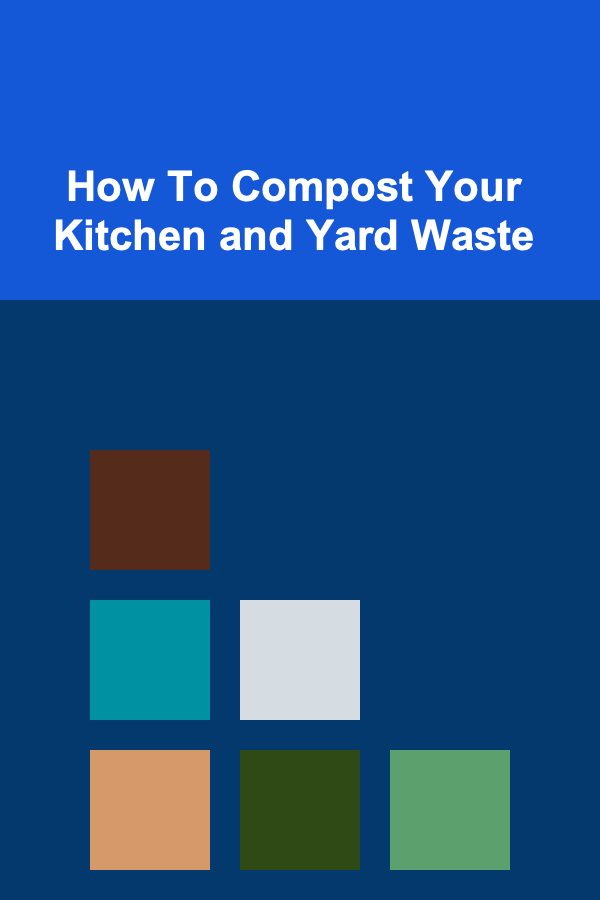
How To Compost Your Kitchen and Yard Waste
ebook include PDF & Audio bundle (Micro Guide)
$12.99$10.99
Limited Time Offer! Order within the next:

Composting is one of the simplest yet most effective ways to manage your organic waste and contribute positively to the environment. By composting your kitchen scraps and yard waste, you can reduce the amount of waste that ends up in landfills, decrease greenhouse gas emissions, and create nutrient-rich soil for your garden. Whether you're a seasoned gardener or a newcomer to the world of composting, this comprehensive guide will walk you through everything you need to know to start composting at home.
What is Composting?
Composting is the natural process of recycling organic material, such as food scraps and yard waste, into nutrient-rich soil. Through the action of microbes, fungi, and other decomposers, organic waste breaks down into humus, a dark, crumbly material that is an excellent soil amendment. By creating compost, you can not only reduce waste but also improve soil health, increase water retention, and support healthy plant growth.
The Benefits of Composting
Composting has numerous benefits that make it an attractive option for homeowners, gardeners, and environmentally-conscious individuals alike. Here are some of the key benefits of composting:
- Waste Reduction: According to the Environmental Protection Agency (EPA), food scraps and yard waste make up nearly 30% of the waste stream in landfills and incinerators. By composting, you can significantly reduce the amount of waste you send to the landfill, helping to conserve space and reduce the environmental impact of waste disposal.
- Soil Enrichment: Compost improves soil structure, texture, and fertility. It increases the soil's ability to retain moisture, reduces the need for chemical fertilizers, and helps to balance soil pH.
- Reduction in Greenhouse Gas Emissions: Organic waste in landfills decomposes anaerobically, producing methane, a potent greenhouse gas. By composting, you can divert waste from landfills and reduce methane emissions.
- Supporting Biodiversity: Healthy soil supports a rich ecosystem of microorganisms, worms, and insects. Compost provides the nutrients necessary to support a diverse and thriving soil ecosystem.
- Cost Savings: By composting, you can reduce the need to purchase synthetic fertilizers, soil amendments, and mulch, saving money in the long run.
What Can You Compost?
When starting a composting project, it's important to know what materials can be composted and what should be kept out of the compost pile. The composting process relies on a balance of carbon-rich ("browns") and nitrogen-rich ("greens") materials. Here's a breakdown of what you can compost:
Kitchen Waste (Greens)
- Fruit and Vegetable Scraps: Peels, cores, and scraps from fruits and vegetables.
- Coffee Grounds and Filters: Coffee grounds are rich in nitrogen, and the filters are compostable as well.
- Eggshells: These add valuable calcium to your compost.
- Tea Bags: Most tea bags are compostable, but check if they contain synthetic materials like plastic.
- Unbuttered Popcorn: Popcorn can break down easily in compost.
- Leftover Rice and Pasta: As long as they are not greasy or oily, these can be composted.
Yard Waste (Browns)
- Dry Leaves: An excellent source of carbon, dried leaves break down slowly, providing structure to the compost pile.
- Grass Clippings: Grass clippings are high in nitrogen but should be added in thin layers to avoid clumping.
- Wood Chips: Small wood chips, sawdust, and shredded wood are great for balancing moisture and adding carbon.
- Twigs and Small Branches: These can be added in small quantities, as they take longer to decompose.
Other Compostable Items
- Shredded Paper: Newspaper, cardboard, and other paper products that do not contain ink made from toxic chemicals can be composted.
- Hair and Fur: Pet hair, human hair, and fur from brushes can be composted in moderation.
Items to Avoid in Composting
While many organic materials are compostable, some should be avoided because they can introduce toxins or pests to your compost pile. These include:
- Meat and Dairy Products: These attract pests and decompose slowly, often producing odors.
- Oily or Greasy Foods: These can disrupt the composting process by creating a slimy mess and attracting pests.
- Pet Waste: Dog or cat waste should not be composted because it may contain harmful pathogens.
- Diseased Plants: If you compost diseased plants, you risk spreading disease to your garden.
- Weeds with Seeds: Weeds with seeds can survive the composting process and spread when the compost is used in your garden.
The Composting Process
Now that you know what materials to compost, let's explore how the composting process works.
The Basics of Decomposition
The decomposition process is primarily driven by microbes, fungi, bacteria, and invertebrates like earthworms. These organisms break down the organic material into simpler compounds, eventually forming humus. The composting process occurs in stages:
- Mesophilic Stage: At the start of the composting process, mesophilic bacteria begin to break down the organic materials. During this stage, the compost pile heats up, reaching temperatures of around 100°F to 140°F (38°C to 60°C).
- Thermophilic Stage: As the compost pile heats up, thermophilic bacteria and fungi take over. These organisms thrive at higher temperatures and continue breaking down the organic material. This stage is crucial for killing pathogens and weed seeds.
- Curing Stage: Once the temperature begins to drop, the compost enters the curing stage. This is when beneficial fungi, bacteria, and worms further break down the material, turning it into dark, crumbly compost.
Factors That Influence the Composting Process
Several factors affect the speed and efficiency of the composting process:
- Temperature: The compost pile should reach temperatures between 130°F and 160°F (54°C to 71°C) for effective decomposition. You can monitor the temperature with a compost thermometer to ensure it is in the optimal range.
- Moisture: Composting requires moisture to support microbial activity, but the pile should not be too wet. The compost should feel like a damp sponge---moist, but not dripping.
- Aeration: Aeration is essential for providing oxygen to the microorganisms that are breaking down the material. Turning the compost regularly (every 1--3 weeks) helps maintain good airflow and prevents the pile from becoming compacted.
- Size and Layering: A good-sized compost pile should be at least 3 feet (1 meter) wide and 3 feet high. This allows enough material for heat to build up and decomposition to occur efficiently. Layering "browns" (carbon-rich materials) and "greens" (nitrogen-rich materials) in alternating layers ensures a balanced compost pile.
Different Composting Methods
There are various composting methods, each suited to different space constraints, time availability, and personal preferences. Here are a few common methods:
1. Traditional Pile or Bin Composting
This is the most straightforward method. You simply create a compost pile in your yard or use a compost bin to contain the materials. A good compost pile should be at least 3 feet wide and 3 feet high to maintain proper heat and aeration.
- Pros: Simple, inexpensive, and can handle a lot of material.
- Cons: Requires regular turning and monitoring.
2. Vermicomposting (Worm Composting)
Vermicomposting uses worms to break down organic waste. Red wigglers are the most commonly used composting worms. This method is ideal for small spaces or people who want to compost kitchen scraps indoors.
- Pros: Efficient and produces high-quality compost (worm castings). Can be done indoors or in small spaces.
- Cons: Requires more maintenance, and worms can be sensitive to temperature fluctuations.
3. Tumbler Composting
A compost tumbler is a sealed container that rotates, making it easier to turn the compost and aerate it. Tumblers are ideal for people who want a quick and low-maintenance composting solution.
- Pros: Fast decomposition, easy to turn, and contained system.
- Cons: Can be expensive, and some models may not handle large amounts of compost.
4. Trench Composting
In trench composting, you dig a trench in your garden and bury your compostable materials directly in the soil. Over time, the organic matter decomposes and enriches the soil.
- Pros: Simple, doesn't require a compost bin or pile.
- Cons: Slower decomposition, and you can't always control the temperature or moisture level.
Troubleshooting Common Composting Problems
While composting is a relatively simple process, there are some common problems that can arise. Here's how to troubleshoot:
1. Smelly Compost
If your compost pile smells foul, it could be due to excess moisture, too many "greens," or poor aeration. To fix this:
- Add more "browns" (such as dry leaves or straw).
- Turn the pile to improve aeration.
- Ensure the pile is not too wet by adding dry materials like shredded paper.
2. Slow Decomposition
If your compost is decomposing too slowly, it could be due to insufficient heat, moisture, or aeration. To speed up the process:
- Turn the pile more frequently to introduce oxygen.
- Ensure the pile is large enough to generate heat.
- Add more nitrogen-rich materials ("greens") to jumpstart decomposition.
3. Pests
If pests are attracted to your compost, it could be due to food scraps that should not be composted, such as meat or dairy. To keep pests at bay:
- Avoid adding non-compostable items.
- Cover food scraps with a layer of brown materials (leaves, straw).
- Use a sealed compost bin to reduce exposure to pests.
Conclusion
Composting is a rewarding and environmentally-friendly practice that allows you to recycle kitchen and yard waste into nutrient-rich soil for your garden. By understanding what materials to compost, how the composting process works, and how to troubleshoot common problems, you can create a successful composting system that benefits both your garden and the planet. Whether you're using a traditional compost pile, a worm bin, or a compost tumbler, the rewards of composting are clear---healthier soil, reduced waste, and a positive environmental impact. Start composting today and take a step toward a more sustainable lifestyle.

How to Cut Costs on Groceries Without Compromising Nutrition
Read More
How to Market Your Accounting Services to Small Business Owners
Read More
How To Make Your Own Pet Toys and Treats
Read More
How to Choose the Right Carbohydrates for Weight Loss
Read More
How to Optimize Database Queries for Faster Performance
Read More
How to Create Your Own Playing Card Throwing Spread
Read MoreOther Products

How to Cut Costs on Groceries Without Compromising Nutrition
Read More
How to Market Your Accounting Services to Small Business Owners
Read More
How To Make Your Own Pet Toys and Treats
Read More
How to Choose the Right Carbohydrates for Weight Loss
Read More
How to Optimize Database Queries for Faster Performance
Read More